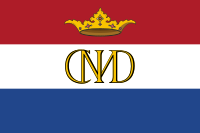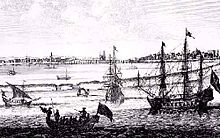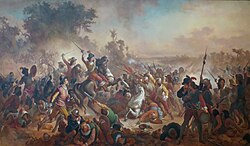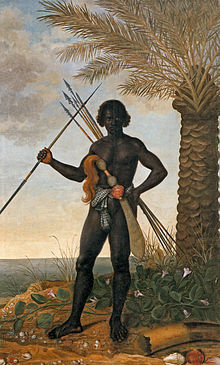Captaincy of Pernambuco
Captaincies were originally horizontal tracts of land (generally) 50 leagues[Note 1] wide extending from the Atlantic Ocean to the Tordesillas meridian.In the years surrounding Brazilian independence, the captaincy was reduced by repartitioning of several previously merged territories, until today's state with the same name was left.In 1630, at the close of this initial period of Portuguese colonization of Pernambuco, then the richest and most successful colony in Brazil, the Dutch attacked with sixty-seven ships, 7000 men, and 1,170 guns.While no single person was solely responsible for the success of Pernambuco during this period, much of the credit belongs to Duarte Coelho Pereira, the first Donatário (Lord Proprietor).By 1555, Jeronimo de Albuquerque had driven the Caetés South and opened up the várzea (flood plain) around the Capibaribe river for settlement and sugar cultivation.Second, while Dona Brites and her brother Jerónimo de Albuquerque continued to guide the captaincy during their lifetimes, the sons and heirs of Duarte Coelho were most often absent, first for education in Portugal, later for service to the crown including their participation at the battle of Alcácer Quibir where both were captured, subsequently ransomed, and after which the second donatário, Duarte Coelho de Albuquerque, died.Philip II ruled all the Spains, he was the effective master of Flanders, Artois, and Franche-Comté disputed ruler of Holland and Zeeland.He was king of Naples and Sicily and through his control of Sardinia and Milan, kept regular communication with his cousins in Austria, thus, the Hapsburgs almost encircled France.In the early Seventeenth Century, the extended visits (sometimes more residences) of the Governors-general can be understood in terms of the expansion of Portuguese colonization of Brazil.It would be 1620 before the Fourth donatário would be allowed to send his brother, Matias de Albuquerque as his representative to exert direct familial control over his captaincy.The Dutch West India Company had gathered considerable intelligence on the defenses of Pernambuco both by the capture of ships at sea and during their previous occupation of Bahia in 1624.As a result, the fleet commander Hendrick Corneliszoon Loncq and the land forces colonel Jonckheer Diederick van Waerdenburgh were well informed as to the weaknesses of Pernambuco's defense.[25] "The most remarkable man ever associated with the sugar industry"[26] Johan Maurits began campaigns against the Portuguese resistance with an attack on Porto Calvo to the south of Recife.[27] Although Maurits would prove exceptionally tolerant for his day and age (allowing considerable freedom of worship, establishing and maintaining good relationships with remaining indigenous peoples, and even refusing to return African slaves who had deserted to the Dutch) the reality of the age and the reality of sugar economy was based on large landholdings, expensive machinery, and slavery.[27] After a campaign against Sergipe, to the South, prompted by guerilla raids (sent by Baguoli) across the São Francisco River and an invitation by the Tapuya tribes to occupy Ceará, to the North, Maurits was urged to attack Bahia.[27] Maurits described Bahia as "a cat not to be taken without gloves"[27] In 1638, the Hapsburg crown at long last was able to send an armada to help expel the Dutch from Brazil's Northeast.With rations again short, the land forces, under Luis Barbalho, were put ashore to march back overland to Bahia having to pass through Pernambuco and Dutch territory all the way.[27] “During his stay in Brazil Johan Maurits gathered around him a carefully selected entourage of forty-six scholars, scientists, artists, and craftsmen from the Netherlands, all of whom had their own special functions and assignment.Piso studied tropical diseases and their remedies, Marcgraf made scientific collections of the fauna, flora, and geography of Brazil and Angola, in addition to astronomical and meteorological observations; while half a dozen painters, including Frans Post and Albert Eckout...filled their portfolios with sketches of every aspect of local life and culture.”[28] He was also appreciative of the need to win the cooperation of the residents of Pernambuco.[29] Under Maurits’ rule Recife, which had been chiefly a village at Olinda's port that supported shipping and catered to seamen, was renamed Mauritsstad.These were supported by the actions of António Teles da Silva, the Governor-general in Bahia, whose machinations, included dispatching troops and suborning Major Dirk Hooghstraten, commander of the key fortress of Pontal de Nazaré to surrender the fort.As had happened at the battle of Monte das Tabocas the Dutch withdrew after nightfall leaving the Pernambucan forces to find themselves the victors the next morning.However, in addition to a large number of Africans imported to Pernambuco, the turmoil and destruction of the guerrilla war against the Dutch provided ample opportunities for slaves to escape and take refuge in Quilombos.Moreover, Africans were not content to live a stone-age existence without metal tools, firearms, and other implements and conveniences, the principal source of which was to raid Portuguese settlements.The sertão (backlands) already was used for cattle ranching and in particular, the valley of the São Francisco River became a popular route feeding would-be miners, equipment, and supplies to the goldfields.[42] The mining boom inevitably diverted both free men and slaves from all Brazilian coastal areas including Pernambuco and drove up prices.Recife, formerly merely the port facility for Olinda, had been developed into a thriving center of commerce populated by wealthy, more recently arrived merchants to whom most of the landed aristocracy of Pernambuco were heavily indebted.[49] Pombal's hatred of the Jesuits led to their subsequent expulsion but the impact on Pernambuco was less than in other areas with greater concentrations of indigenous peoples.The Jesuits had long maintained primacy in education in the Portuguese empire thru their control of the universities at Coimbra and Evora and locally in Olinda by way of their Collegio.The most significant event in the late Eighteenth Century was external, the slave rebellions in Santo Domingo and Haiti, and the consequent destruction of sugar production there.











PortugueseBrazilDutch BrazilIndependence of BrazilUnited Kingdom of Portugal, Brazil and the AlgarvesAtlantic Oceancolonial BrazilCaptaincy of São VicentePernambucoParaíbaAlagoasRio Grande do NorteCearáMinas GeraisHistory of BrazilMiller AtlasPre-CabralineKuhikuguMarajoara cultureTreaty of TordesillasPedro Álvares Cabral's voyageEuropean discoveryLetter of Pero Vaz de CaminhaCaptainciesSugar cycleSlaverySlave tradeState of BrazilFrance AntarctiqueBandeirantesJesuit missionsQuilombo dos PalmaresFrance EquinoxialeDutch invasionsGold cycleWar of the EmboabasMascate WarVila Rica RevoltSpanish–Portuguese War (1735–1737)Treaty of MadridGuaraní WarSpanish–Portuguese War (1776–1777)Minas Gerais ConspiracyTransfer of the Portuguese court to BrazilInvasion of the Banda OrientalUnited Kingdom with PortugalPernambuco RevoltConquest of French GuianaConquest of the Banda OrientalConstituent Cortes of 1820IndependenceDia do FicoWar of IndependenceRecognition of IndependenceEmpire of BrazilReign of Pedro I1823 Constituent AssemblyNight of Agony1824 ConstitutionConfederation of the EquatorCisplatine WarAbdication of Pedro IRegency PeriodApril Revolt1834 Additional ActMalê RevoltCabanagemRagamuffin WarBalaiadaDeclaration of majority of Pedro IIReign of Pedro IILiberal rebellions of 1842Praieira revoltCoffee cycleEusébio de Queirós LawPlatine WarChristie AffairUruguayan WarParaguayan WarReligious IssueRevolt of the MuckersGrande SecaMilitary QuestionAbolition of SlaveryPost–abolition of slaveryOld RepublicProclamation of the Republic1891 ConstitutionEncilhamentoNavy RevoltsFederalist RevolutionBelle ÉpoqueCoffee with milk politicsCoronelismAmazon rubber boomWar of CanudosAnnexation of AcreVaccine RevoltTaubaté AgreementNaval arms raceRevolt of the LashContestado WarWorld War ILieutenant revoltsVargas EraRevolution of 1930Constitutionalist Revolution1934 ConstitutionCommunist uprising of 1935Estado Novo1937 Brazilian coup d'état1937 ConstitutionIntegralist UprisingWorld War IIOusting of Getúlio VargasPopulist RepublicLott's preventative coupAragarças RevoltConstruction of BrasíliaLegality CampaignPlano TrienalSailors' RevoltMilitary dictatorship1964 Brazilian coup d'étatVacancy in the PresidencyInstitutional Acts